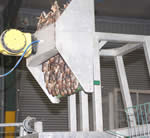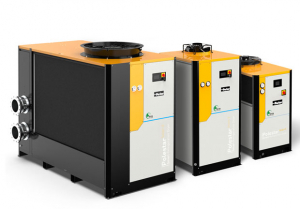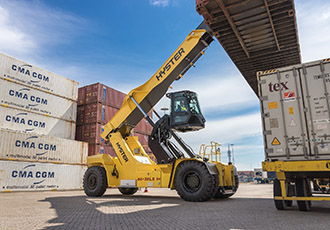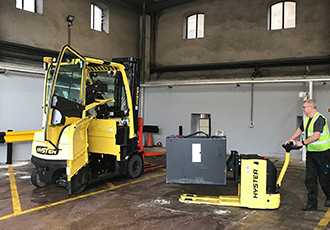Robots take the load for fish processor
17th December 2009
Source:
FANUC Robotics

A Grimsby fish processor has successfully implemented robots into its facility to remove the heavy and repetitive load and unloading tasks. Producing dried fish, JHS Fish Products Limited has two FANUC Robotics robots handling palletised fish at both the raw and the dry stages of the process.
JHS is strategically located in Grimsby to take fish heads, tails, fins, backbones and lugs from other fish processors in the area. What other processors classify as waste, or offal, has a very specific market in Nigeria where a fish flavoured stock is produced and added to a favourite stew delicacy.
Although the drying process gives the fish at least a twelve month life without refrigeration, the quality of the waste and it processing is important. Fresh waste is received and the fish parts are manually laid out in specific patterns onto 80cms x 80cms trays weighing up to 30Kgs when complete.
The trays travel by conveyor to a palletising area where a FANUC Robotics R2000iA picks one at a time and stacks them on top of each other by accurately positioning the tray legs. As the fish is raw at this stage, the robot has a gator to protect it from the large amounts of water in the area. Trays are stacked to 2Mtr height and are automatically conveyed out of the robot area when complete.
Olafur Einarsson, Operations Director, JHS Fish Products, comments, “It is unthinkable for us to consider any other way to handle the trays. At our old factory in Iceland the operation used to be manual and mechanical using dedicated automation - it was very unreliable, very noisy and shaky. Manual handling involved two people per tray and the need to bend below the knee and reach over the shoulder making it a tiring task.
“The problem was resolved by Samey EHF an Icelandic company and a Strategic Systems Partner of Fanuc Robotics UK. Samey were able to apply a great deal of experience applying automation into the fish industry to help us overcome our handling issues. ”
When the drying process is complete the fish have to be removed from the trays and packed into sacks. At this stage the second robot, another FANUC Robotics R2000iA, de-stacks the trays and empties the fish into a hopper.
Olaf explains, “This process is not so straight-forward as the drying process releases juices onto the trays and this makes the fish difficult to remove. Again robots have given us a smooth efficient process – the trays have about nine hundred holes moulded into them which we align, using the robot, with a vertically mounted bed of pins which go through the holes and push off the fish.
“Our previous manual and mechanical system caused a lot of damage to the pallets and the problem with manually carrying out this task is that its almost impossible to align the pins without causing damage. This system has been in operation now for three years and, other than lubrication, it has required no attention at all.”
JHS had no robotics skills within the company and employed one of the temporary contractors that had assisted Samey during the installation and commissioning period. “The system is straight-forward and operates efficiently – working with a robotics integrator that really knows the fish industry is important and gave us a lot of confidence. We are now actively looking to employ robots wherever possible and the loading of raw fish to trays is just one consideration. “
Although the drying process gives the fish at least a twelve month life without refrigeration, the quality of the waste and it processing is important. Fresh waste is received and the fish parts are manually laid out in specific patterns onto 80cms x 80cms trays weighing up to 30Kgs when complete.
The trays travel by conveyor to a palletising area where a FANUC Robotics R2000iA picks one at a time and stacks them on top of each other by accurately positioning the tray legs. As the fish is raw at this stage, the robot has a gator to protect it from the large amounts of water in the area. Trays are stacked to 2Mtr height and are automatically conveyed out of the robot area when complete.
Olafur Einarsson, Operations Director, JHS Fish Products, comments, “It is unthinkable for us to consider any other way to handle the trays. At our old factory in Iceland the operation used to be manual and mechanical using dedicated automation - it was very unreliable, very noisy and shaky. Manual handling involved two people per tray and the need to bend below the knee and reach over the shoulder making it a tiring task.
“The problem was resolved by Samey EHF an Icelandic company and a Strategic Systems Partner of Fanuc Robotics UK. Samey were able to apply a great deal of experience applying automation into the fish industry to help us overcome our handling issues. ”
When the drying process is complete the fish have to be removed from the trays and packed into sacks. At this stage the second robot, another FANUC Robotics R2000iA, de-stacks the trays and empties the fish into a hopper.
Olaf explains, “This process is not so straight-forward as the drying process releases juices onto the trays and this makes the fish difficult to remove. Again robots have given us a smooth efficient process – the trays have about nine hundred holes moulded into them which we align, using the robot, with a vertically mounted bed of pins which go through the holes and push off the fish.
“Our previous manual and mechanical system caused a lot of damage to the pallets and the problem with manually carrying out this task is that its almost impossible to align the pins without causing damage. This system has been in operation now for three years and, other than lubrication, it has required no attention at all.”
JHS had no robotics skills within the company and employed one of the temporary contractors that had assisted Samey during the installation and commissioning period. “The system is straight-forward and operates efficiently – working with a robotics integrator that really knows the fish industry is important and gave us a lot of confidence. We are now actively looking to employ robots wherever possible and the loading of raw fish to trays is just one consideration. “
Similar articles
More from FANUC Robotics
- The 'strongest' robot in the world 12th June 2015
- FANUC receive award for thriving apprentice programme 28th February 2013
- Greenvale capitalise on robot’s flexibility 24th June 2011
- Robot gets to grips with flexible PVC floor tiles 10th March 2011




.jpg)







Write a comment
No comments